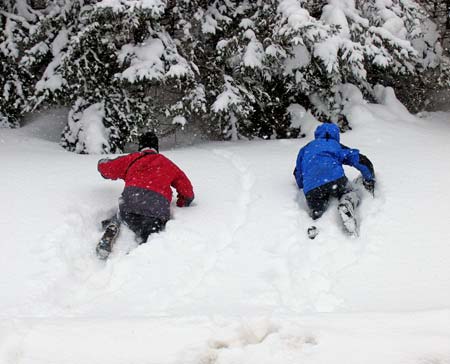|
Home →
Algonquin Winter Tracking
Algonquin Winter Tracking Expedition 2006
|
Tuesday (Day 3)
|
 |
Today we headed east along
Highway 60 (the main highway through Algonquin Park) and
found a nice otter trail heading across the road into the
bush. This being the only trail we spotted in 25 km of
driving, we decided to follow it. This required that we
stash the vehicles somewhere down the road. Due to the heavy
snow, there were no shoulders along the highway on which to
park. |
|
 |
First two of the group scouted
the trail to see if it was worth following. Without
snowshoes, this is the only way to travel in 4-foot deep
snow! They put snowshoes on once we decided to follow this
trail. |
|
 |
This is the otter's trail as
it came down to the road on the other side. Otters, as well
as mink, like to slide a lot in the winter. |
|
 |
In fact, in winter a good part
of an otter's trail is sliding, and actual tracks are
sometimes very hard to locate. |
|
 |
The trail led us through an
alder swamp, which was very challenging for those wearing
the modern smaller snowshoes, as they don't stay on top of
the snow as well as the older style wooden snowshoes. The
alders were all bent over with heavy snow, and at times we
were walking five feet or more above the actual ground
surface! We ended up at this frozen bog, where the otter
went through a hole in the ice into the creek. |
|
 |
After a break for lunch we
headed back to the research station and went off exploring
on our own for the rest of the afternoon. I headed to nearby
Bat Lake, shown here. |
|
| |
|
Previous
Next |
|
|